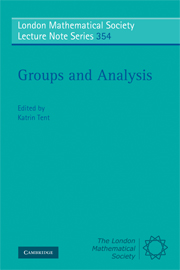Book contents
- Frontmatter
- Contents
- Preface
- List of speakers and talks
- 1 Harmonic analysis on compact symmetric spaces
- 2 Weyl, eigenfunction expansions, symmetric spaces
- 3 Weyl's work on singular Sturm–Liouville operators
- 4 From Weyl quantization to modern algebraic index theory
- 5 Sharp spectral inequalities for the Heisenberg Laplacian
- 6 Equidistribution for quadratic differentials
- 7 Weyl's law in the theory of automorphic forms
- 8 Weyl's Lemma, one of many
- 9 Analysis on foliated spaces and arithmetic geometry
- 10 Reciprocity algebras and branching
- 11 Character formulae from Hermann Weyl to the present
- 12 The Classification of affine buildings
- 13 Emmy Noether and Hermann Weyl
11 - Character formulae from Hermann Weyl to the present
Published online by Cambridge University Press: 12 May 2010
- Frontmatter
- Contents
- Preface
- List of speakers and talks
- 1 Harmonic analysis on compact symmetric spaces
- 2 Weyl, eigenfunction expansions, symmetric spaces
- 3 Weyl's work on singular Sturm–Liouville operators
- 4 From Weyl quantization to modern algebraic index theory
- 5 Sharp spectral inequalities for the Heisenberg Laplacian
- 6 Equidistribution for quadratic differentials
- 7 Weyl's law in the theory of automorphic forms
- 8 Weyl's Lemma, one of many
- 9 Analysis on foliated spaces and arithmetic geometry
- 10 Reciprocity algebras and branching
- 11 Character formulae from Hermann Weyl to the present
- 12 The Classification of affine buildings
- 13 Emmy Noether and Hermann Weyl
Summary
Introduction
In 1926 Hermann Weyl published a paper that contains his character formula for irreducible finite dimensional complex representations of complex and real semi-simple Lie groups and their Lie algebras. It can also be interpreted as a character formula for connected compact groups and for semi-simple algebraic groups in characteristic 0. (Here I am using modern terminology; when Weyl wrote his paper, terms like “Lie groups” were not yet in use.)
When we look at Weyl's character formula as a statement for Lie algebras, then it is a theorem on purely algebraic objects. However, Weyl used analytic methods to prove it. Not surprisingly, people looked for algebraic proofs. These attempts were finally successful and led also to useful reformulations of Weyl's formula. This development will be described in the first section of this survey.
The other topic to be discussed will be the search for analogues to Weyl's formula in more general cases. To start with, a finite dimensional complex semi-simple Lie algebra has an abundance of irreducible representations that are infinite dimensional. It was natural to look for character formulae for at least some families of representations sharing features of the finite dimensional ones — for example those generated by a highest weight vector.
Furthermore, it was also natural to go beyond finite dimensional complex semi-simple Lie algebras. There are several algebraic objects that share many structural features with these Lie algebras and that have similar representation theories.
- Type
- Chapter
- Information
- Groups and AnalysisThe Legacy of Hermann Weyl, pp. 232 - 270Publisher: Cambridge University PressPrint publication year: 2008
- 4
- Cited by



